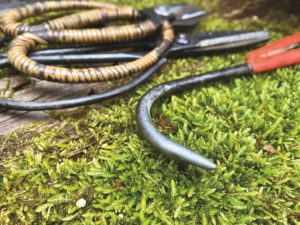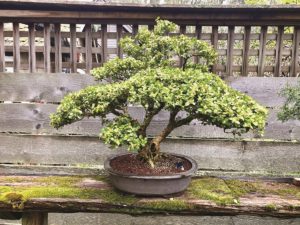My introduction to bonsai was an encounter with a collection of straggly little junipers in pots in a friend’s yard. The plants were root-bound and malnourished, and they had taken on the gray-green color that precedes death. They were not happy. Bonsai are “small, tortured trees” I was told. It was an uninspiring introduction. But it left me curious. I started reading about the art. The belief expressed in those words of introduction is a common misconception. It is far from the truth.
The word bonsai, translated to English, means “planted in a container.” A bonsai is a tree grown in a decorative container, shaped to look like a full-size tree. For that to happen, the tree must be exceptionally healthy.

Bonsai comes from a Chinese horticultural tradition adopted and perfected by the Japanese over a thousand years ago. Principles of Zen Buddhism were integrated, and an art form was born. The bonsai artist, the tree’s caretaker, strives to achieve the aesthetics of a tree one would find in nature, the feeling of being near a tree bearing some truth or story that invites the viewer to stop and be still.
Just like a landscape painting, a garden, or a flower arrangement, a bonsai brings elements of untamable nature into our own world, into our yard, into our home, on a scale we can handle. The outcome is a satisfying result, but the well-executed process is the goal. As the caretaker trains the trees, the trees tend to shape the caretaker as well.
Every spring, sometime between mid-March and mid-April, trees that have been in the same soil for two or three years need to be repotted. Trees in nature send their roots out into new soil. Bonsai, confined to their pots, need the caretaker’s hand to do that. Otherwise, they will eventually fill their containers and begin to compact the soil, losing their ability to absorb oxygen, water, and nutrients.
When it’s time to repot, the tree is carefully lifted from its container, its roots a mass of white, a cast of the pot’s interior. A metal root hook, its point polished from years of moving through coarse soil, is used to loosen the roots. The hook is pulled outward, coaxed and drawn, from the root flare to the fleshy, white root tips. The delicate tendrils are held and straightened. When ever are a tree’s roots held in a hand? Fingers, upturned, massage the soil free. It falls away. The compacted clay and stone, pumice and gravel break apart. Over the years, salts and toxins have built up in the soil from fertilizers. These things will inhibit the health of the tree in time if not removed. With some help, doing what the tree cannot do on its own, the things that no longer serve the tree are let go of.
The mind wanders. Habits, resentments, grudges. Two years of buildup. Toxins. Things to let go of.
Free of soil, the tree is an organism independent of the earth. Its secret half, the part we never see, sits on the workbench. A wooden body, flesh and energy, seeking to create more of itself. It seems both terribly vulnerable and immensely strong.
The caretaker’s job is to provide the tree with the conditions in which it can thrive. She can not make it grow. She can only create the possibility for growth to be the natural outcome. If a bonsai is struggling, it is not by any fault of the plant. Life seeks only to thrive; it is the conditions that must be changed.
How different are we really?

Sharp shears are used, roots held outstretched, the tips cut away. Long coarse roots are removed. Damage, rot, misdirected shoots that do more harm than good are taken with clean, careful cuts. The work must be fearless. Just as we clean the canopies of trees, the parts the world sees, the roots, the parts no one sees, must also be pruned. As above, so below.
How to make more space to grow within the container that is oneself? What can be cut away to create space? What to let go of? What to add?
The pot is prepared with wires passed through the drainage holes to anchor the tree. A mixture of fresh new soil, free of the weight of the past years, is poured in around the roots. Chopsticks are pushed into the spaces and rocked gently to let the soil fill in and settle. The tree is watered until the water drains through the soil as clear as rain.
What are my roots? What is my fresh soil? What is my water?
The hose is turned off. The tools are put away. The tree is placed back on its stand.
New England Bonsai Gardens in Bellingham is an excellent resource on bonsai. They offer classes and have a massive collection of materials for beginners and experts alike.



